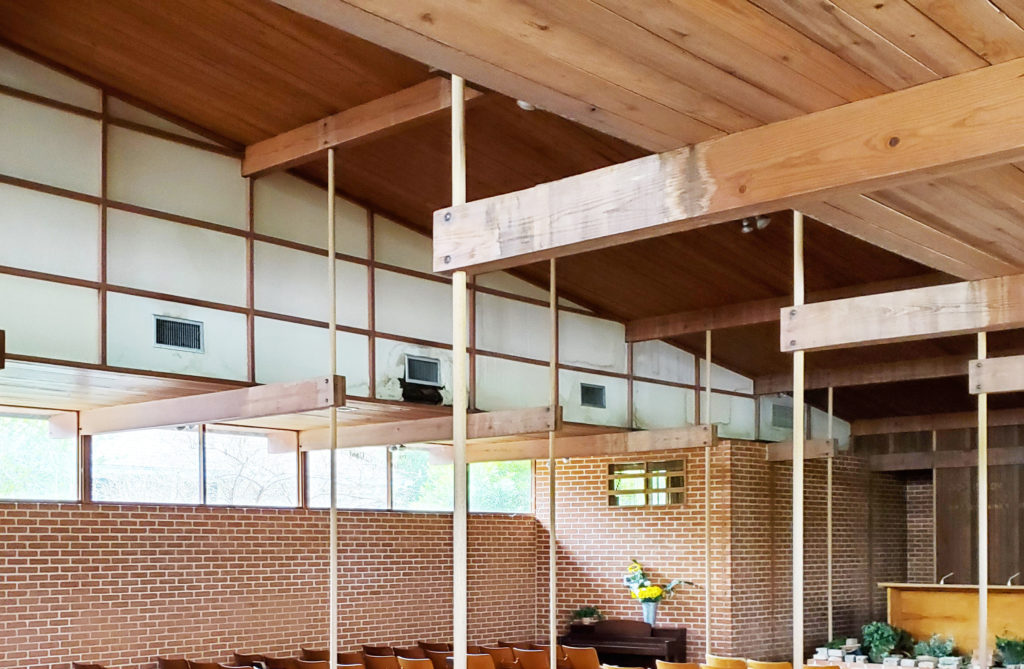Resilience Treatments & Strategies
Interior Wall Finishes

Description
Lightweight materials applied over interior walls’ structural elements. They protect the structure and also have an aesthetic purpose. Common historic finishes for interior walls include plaster, wood paneling, and gypsum wall board (a.k.a. Sheetrock®). Interior finishes are often painted for aesthetics, which may be culturally significant.
Typical risk factor of this component:
Very Low
Interior wall finishes are typically not exposed to elements such as wind and rain. They have negligible importance to the structure’s stability and their failure would have little to no impact on other assemblies.
Typical Damages from Floods or Hurricanes
- Mold growth
- Rising damp or salt crystallization within walls
- Waterlogged or otherwise water-damaged finishes (e.g., buckling, bowing, cupping, or swelling)
- Blistering, peeling, bubbling, or scouring plaster
- Delamination of layered or composite finishes
Other common conditions contributing to vulnerability towards floods or hurricanes
- Lower interior floor level than exterior grade
- Defects (e.g., scratches, flaking paint, peeling wallpaper) in interior finishes
Resilience Treatments and Strategies
In-house
Air out the building immediately following water infiltration and saturation. Avoid using forced ventilation to avoid drying surfaces too quickly, unless you know the finish will not be damaged by the practice. If mold is present, consult specialists that treat hazardous materials.
Quickly clean and disinfect surfaces after airing them out. Use cleaners and soft brushes that are appropriate for the type of surface and potential biological growth (see also NPS Preservation Brief #6).
Carefully remove all finishes that are waterlogged and cannot be saved or if necessary to dry out underlying material (if it is safe to do so, e.g., there is no mold or asbestos). Replace with in-kind elements. Refinish/restore anything that can be saved.
Patch or repair minor flaws in interior finishes, (see also NPS Preservation Briefs #21 and #28). Use finishes that can be cleaned easily, if appropriate. Carefully reattach finishes such as wallpaper with appropriate adhesives (e.g., pure wheatstarch paste).
Implement an integrated pest management plan.
Consider applying a non-absorptive finish (e.g., a tile wainscot) to the base of walls, if appropriate.
Professional needed [type]
Remove and dispose of hazardous materials such as asbestos and lead paint (see also NPS Preservation Brief #37) [EPA licensed contractors].
Restore decorative painting, murals, plasterwork, or carvings (see also NPS Preservation Briefs #23, #28, and #34) [building or art conservation professionals].
Install vapor barrier within wall cavity if appropriate for wall assembly type (see also NPS Preservation Brief #39) [architect].
Interior Wall Finishes

Description
Lightweight materials applied over interior walls’ structural elements. They protect the structure and also have an aesthetic purpose. Common historic finishes for interior walls include plaster, wood paneling, and gypsum wall board (a.k.a. Sheetrock®). Interior finishes are often painted for aesthetics, which may be culturally significant.
Typical risk factor of this component:
Very Low
Interior wall finishes are typically not exposed to elements such as wind and rain. They have negligible importance to the structure’s stability and their failure would have little to no impact on other assemblies.
Typical Damages from Floods or Hurricanes
- Mold growth
- Rising damp or salt crystallization within walls
- Waterlogged or otherwise water-damaged finishes (e.g., buckling, bowing, cupping, or swelling)
- Blistering, peeling, bubbling, or scouring plaster
- Delamination of layered or composite finishes
Other common conditions contributing to vulnerability towards floods or hurricanes
- Lower interior floor level than exterior grade
- Defects (e.g., scratches, flaking paint, peeling wallpaper) in interior finishes
Resilience Treatments and Strategies
In-house
Air out the building immediately following water infiltration and saturation. Avoid using forced ventilation to avoid drying surfaces too quickly, unless you know the finish will not be damaged by the practice. If mold is present, consult specialists that treat hazardous materials.
Quickly clean and disinfect surfaces after airing them out. Use cleaners and soft brushes that are appropriate for the type of surface and potential biological growth (see also NPS Preservation Brief #6).
Carefully remove all finishes that are waterlogged and cannot be saved or if necessary to dry out underlying material (if it is safe to do so, e.g., there is no mold or asbestos). Replace with in-kind elements. Refinish/restore anything that can be saved.
Patch or repair minor flaws in interior finishes, (see also NPS Preservation Briefs #21 and #28). Use finishes that can be cleaned easily, if appropriate. Carefully reattach finishes such as wallpaper with appropriate adhesives (e.g., pure wheatstarch paste).
Implement an integrated pest management plan.
Consider applying a non-absorptive finish (e.g., a tile wainscot) to the base of walls, if appropriate.
Professional needed [type]
Remove and dispose of hazardous materials such as asbestos and lead paint (see also NPS Preservation Brief #37) [EPA licensed contractors].
Restore decorative painting, murals, plasterwork, or carvings (see also NPS Preservation Briefs #23, #28, and #34) [building or art conservation professionals].
Install vapor barrier within wall cavity if appropriate for wall assembly type (see also NPS Preservation Brief #39) [architect].